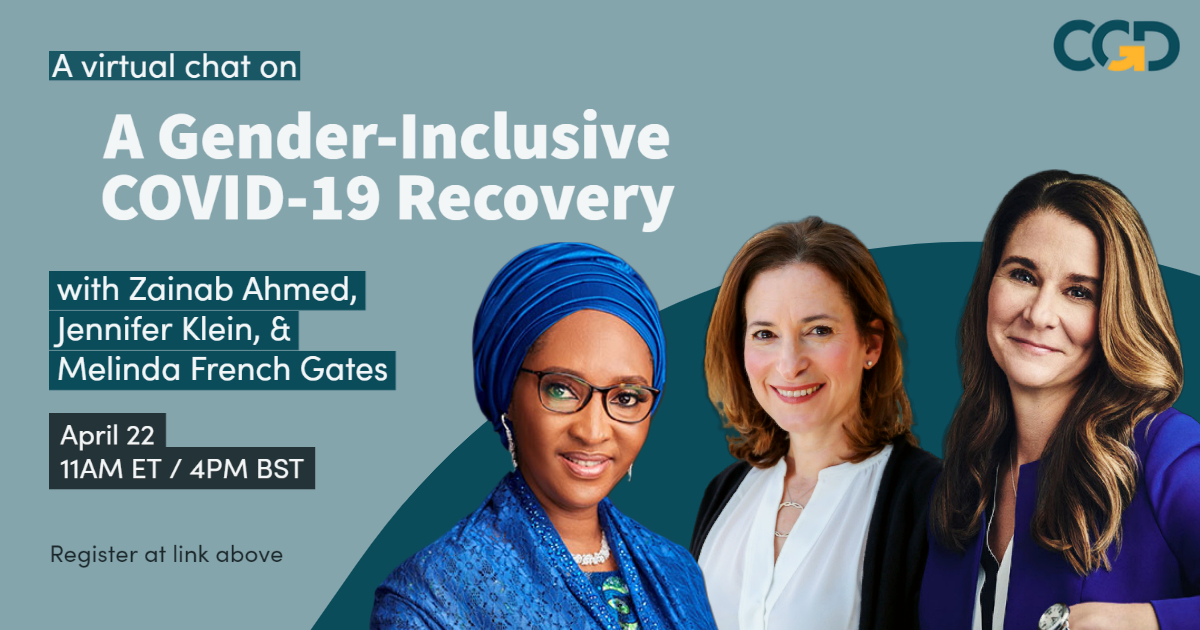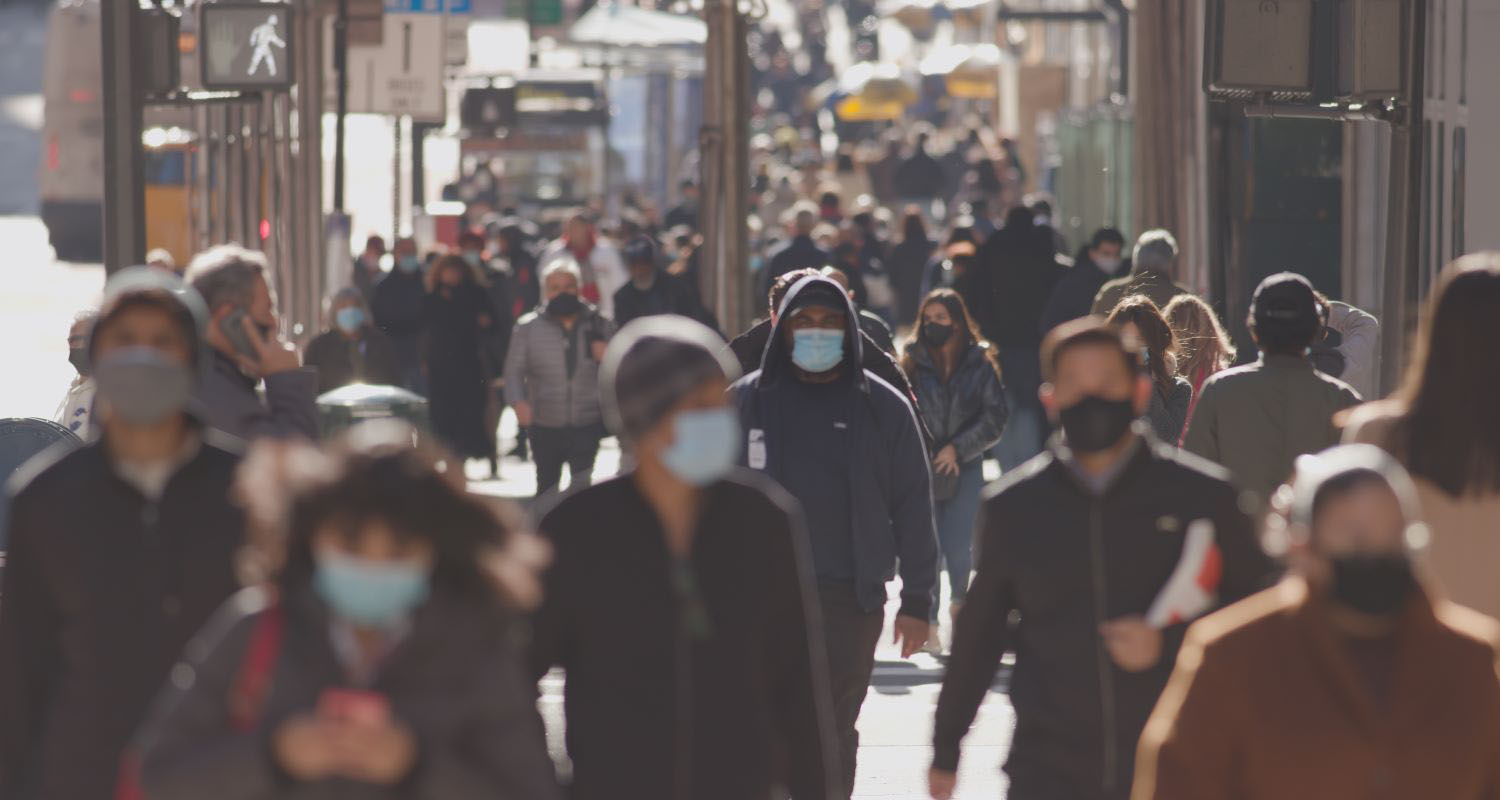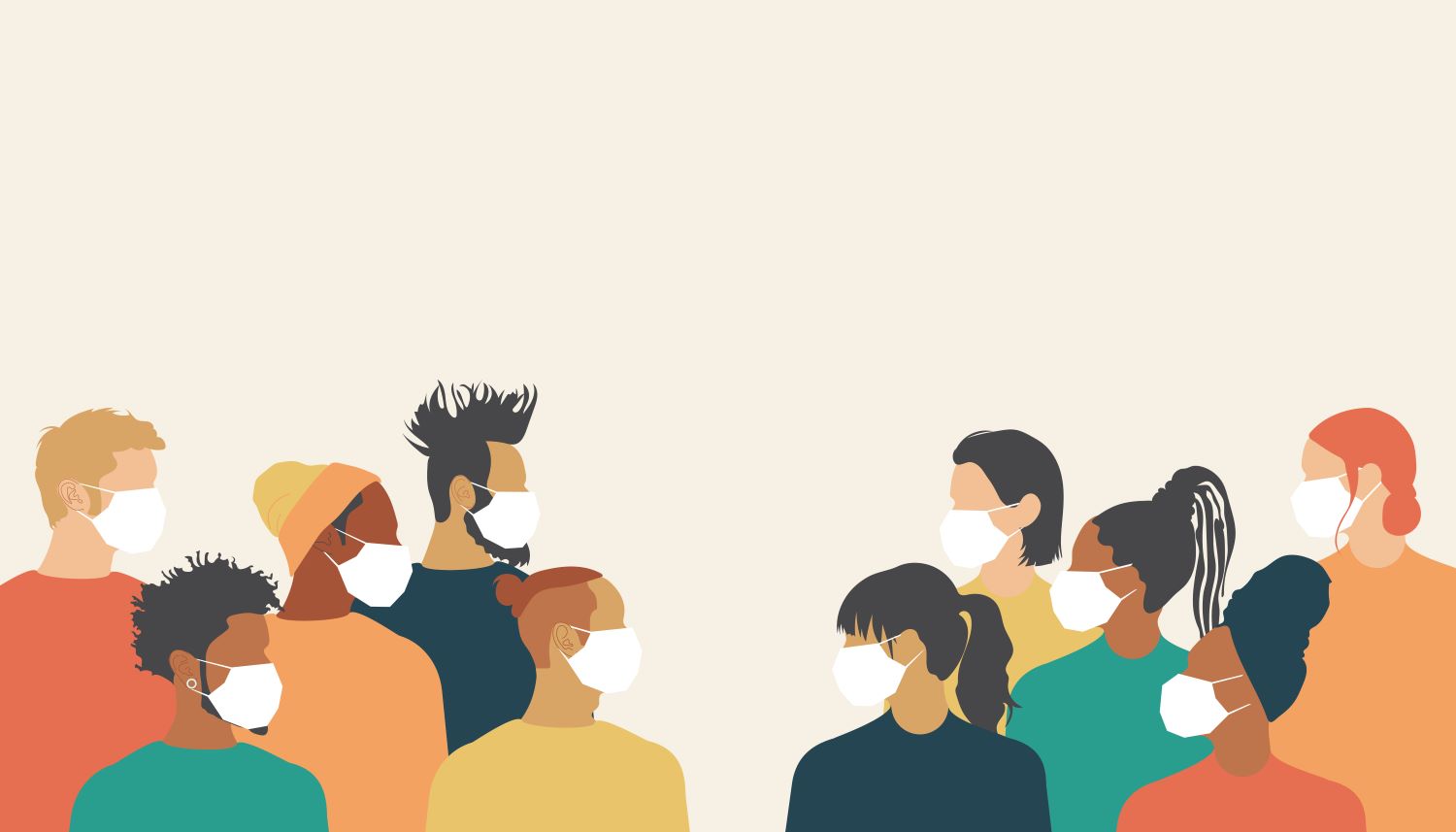Recommended

Event
Two years into a global pandemic, the world is still trying to contain the virus as well as make up lost ground on economic and social progress, especially for women and girls. Our work through CGD’s COVID-19 Gender and Development Initiative has revealed the outsized impacts women have faced in employment and income losses, business closures, and growing care burdens, as well as the need for more and better data to understand the full extent of the pandemic’s impact and the path forward.
To address these challenges, we have identified three priority areas to promote an inclusive recovery, as well as improve women’s well-being and reduce gender inequalities in the longer term. Through strategic investments in “cash, care, and data,” we can increase women’s economic security and opportunity and better inform and monitor progress towards global gender equality. To discuss this agenda, CGD will host Nigerian Minister of Finance Zainab Ahmed, Co-Chair of the Bill & Melinda Gates Foundation Melinda French Gates, and Executive Director of the White House Gender Policy Council Jennifer Klein on Friday, April 22. Be sure to register and tune in as we discuss the case for “cash, care, and data.”
Cash
During the pandemic, women have lost their jobs at a higher rate than men—in contexts as varied as South Africa, Peru, Chad, China, India, and Paraguay. Analysis by the World Economic Forum suggests that globally, men’s employment has already rebounded to pre-pandemic levels, while women’s has not.
In the realm of entrepreneurship, Charles Kenny and George Yang estimate that in the first year of the pandemic, women-owned businesses were 1.4 times as likely to close as men-owned businesses, with women’s firms more likely to close regardless of firm size, age, or sector. Evidence from the World Bank suggests that this gender difference in firm closure rates could be due to women’s firms’ greater liquidity constraints and vulnerability to shocks, as well as their lower likelihood of receiving public support.
One solution to both these problems is to deliver cash to the workers, businesses, and sectors most impacted—which suggests the need to target support to women.
Since the beginning of the pandemic, 962 cash transfer measures have been implemented in over 200 countries. These range from highly targeted programs, such as Burkina Faso’s cash transfer to informal fruit and vegetable sellers, to universal programs, such as those in Singapore and Hong Kong. Many countries introduced a patchwork of targeted programs through expanding existing cash transfers and implementing new measures to fill the gap left by unemployment caused by the economic downturn. The Philippines is one such example, reaching about 96 percent of the population through multiple cash transfer programs over the course of two years.
Most of these programs, however, were temporary, with an average duration of only 4.5 months. As of January 2022, only 96 measures (20 percent of measures with a known status) were ongoing, in spite of the pandemic’s continued economic consequences. Even in the context of shrinking fiscal space, governments—with the support of international financial institutions and donor agencies—should prioritize maintaining cash transfer programs and ensuring that they are designed and implemented to reach and benefit women in need of social safety net support.
There is significant evidence on the positive return on investment of such programs. Analysis of Mexico’s Oportunidades program (later Prospera), of which the majority of recipients are women, shows a rate of return of nearly 18 percent, raising household consumption even after program benefits end. Cash transfers to support women’s microenterprises have also been shown to have a positive return on investment, with evidence in Uganda showing women increasing their capital stock by more than 100 percent relative to a control group.
Cash support should also extend beyond direct cash transfers to women and their households. Policymakers and donors should also bolster the areas of the economy where women predominate. This means providing capital and other forms of support to women-owned firms or firms that disproportionately employ women, or investing in women-dominated sectors, such as education, services, or healthcare.
Care
Women have always performed the majority of unpaid care work, whether to support children, parents, or those living with illnesses or disabilities. During the pandemic, this scale tipped even more: Charles Kenny and George Yang estimate that women performed an additional 173 hours of unpaid childcare work during the pandemic, in contrast to 59 hours performed by men. Reducing the amount of unpaid care work women perform presents a huge opportunity to free their time for other pursuits, including employment or entrepreneurship.
Despite this, international financial institutions and donor agencies have never made the reduction and redistribution of care a core priority. Our analysis of eight multilateral development banks showed that from 2000 to 2021, only $2.08 billion USD went to dedicated childcare projects. Compare this to $2.2 billion USD the World Bank alone committed to oil and gas projects in 2021. The largest bilateral donor countries have also not prioritized care; for all G7 countries in 2019, investments in early childhood education (the closest equivalent in available data) made up only 0.07 percent of total official development assistance.
This is a missed opportunity. Investing in care can allow previously unemployed or underemployed unpaid caregivers to enter or advance within the labor market—and create jobs for paid caregivers. New analysis from Fraym finds that addressing primary caregivers’ childcare needs could lead to an 8-percentage point increase in the labor force participation rate in Nigeria, or roughly 9 million people entering or reentering the labor force. Forthcoming analysis from Eurasia Group estimates that if high-quality childcare was provided to all women, we could reduce the global gender pay gap by 8.6 percent, or $527 billion USD. Nigeria would see the largest improvement, with a 31 percent increase in economically active women as a result of access to care.
Momentum is building to make care a priority through a new childcare incentive fund at the World Bank, a first-ever childcare investment target set through the IDA20 replenishment, and a $650 million dollar commitment by the Bill and Melinda Gates Foundation to invest in women’s economic empowerment through care and other priorities. There are many more opportunities for other donors and multilaterals to follow suit. The Build Back Better World partnership through the G7, a commitment to invest in infrastructure in low- and middle-income countries, could prioritize care infrastructure, for example.
Data
The pandemic has underscored how difficult it is to implement inclusive and effective policies and investments when policymakers and investors don’t have data on the populations they aim to reach or the likely impact of their choices. Despite having implemented over 3,800 social protection and labor market measures since the start of the pandemic, many governments and international financial institutions still have little information regarding the effectiveness of these measures, including from a gender perspective.
The data we have available for the moment is confined to the realm of intention rather than impact, and even here what we see is not encouraging. Our analysis of 277 project documents from the World Bank, Asian Development Bank, African Development Bank, and Inter-American Development Bank shows that less than half of COVID-19 response projects have included gender-related indicators or targets. Evidence from the UNDP/UN Women COVID-19 Global Gender Response Tracker shows that of 4,968 COVID response measures across 226 countries and territories, only 32 percent are gender-sensitive.
Through the IDA20 replenishment, the World Bank has committed to supporting 34 IDA countries to strengthen institutions and build capacity to reduce gender data gaps, up from the previous replenishment commitment to support 30 countries. This is an important step in expanding national statistical capabilities to monitor progress towards gender equality—but more will be needed across institutions to address gender data limitations. Data systems can harness new forms of data such as geospatial or mobile data, as well as work to strengthen data protection, particularly for vulnerable populations. If policymakers invest in data systems, we will have a better understanding of how investments in all areas of development are impacting people of different genders, as well as those faced with intersecting forms of inequality based on location, income level, age, and other demographic characteristics.
According to the World Economic Forum’s latest Global Gender Gap Report, the gender gap in economic participation and opportunity will need another 267 years to close. This is up from 257 years estimated before the pandemic, meaning that we’ve lost a decade of progress towards economic equality. By prioritizing investments in “cash, care, and data,” governments and donors can make up lost ground.
Remember to register or tune in live to our conversation on “cash, care, and data” with Minister Zainab Ahmed, Melinda French Gates, and Jennifer Klein on Friday, April 22!
Disclaimer
CGD blog posts reflect the views of the authors, drawing on prior research and experience in their areas of expertise. CGD is a nonpartisan, independent organization and does not take institutional positions.
Image credit for social media/web: Juan Arredondo/Getty Images/Images of Empowerment





